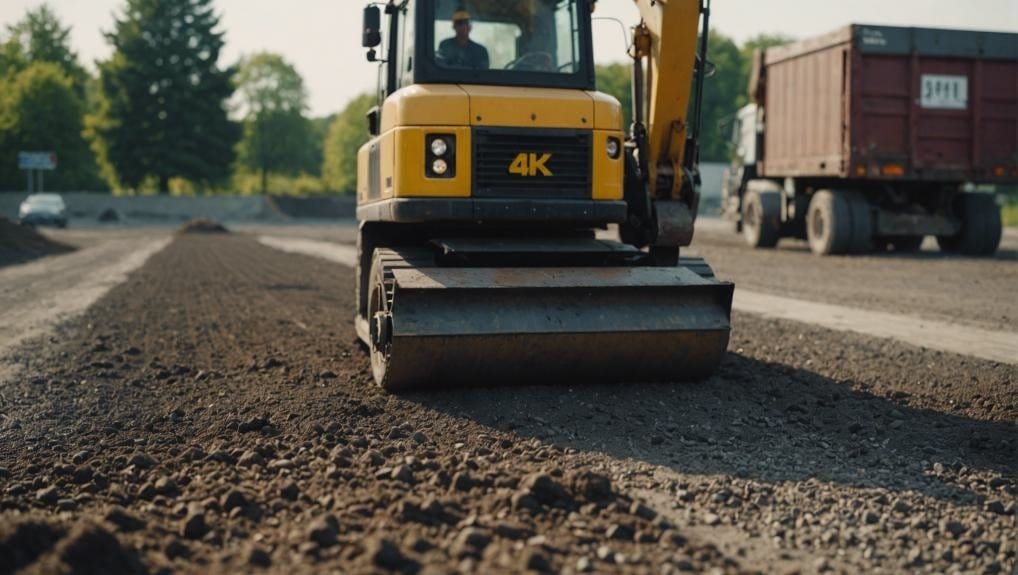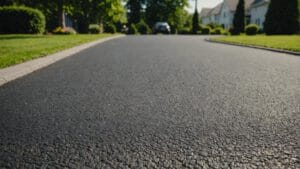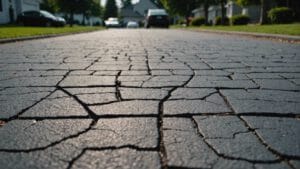Transform your property with an asphalt driveway using these steps: Plan layout, clear site, compact soil, add gravel base, apply hot asphalt, then let it cure. Make sure drainage is at its best, compact soil properly, and select suitable subbase material. Strengthen with binder and finish course, compact each layer, and seal regularly for longevity. Maintain with annual checks, quality sealant, crack filling, and debris clearance. These simple steps will guide you towards a durable and visually appealing driveway. Follow them closely for a successful installation and lasting results.
Key Takeaways
- Clear the site and mark boundaries for layout accuracy.
- Compact soil and add gravel base for stability.
- Apply hot asphalt evenly to cover the driveway area.
- Allow the asphalt to cure before driving on it.
- Ensure proper drainage and regular maintenance for longevity.
Site Preparation
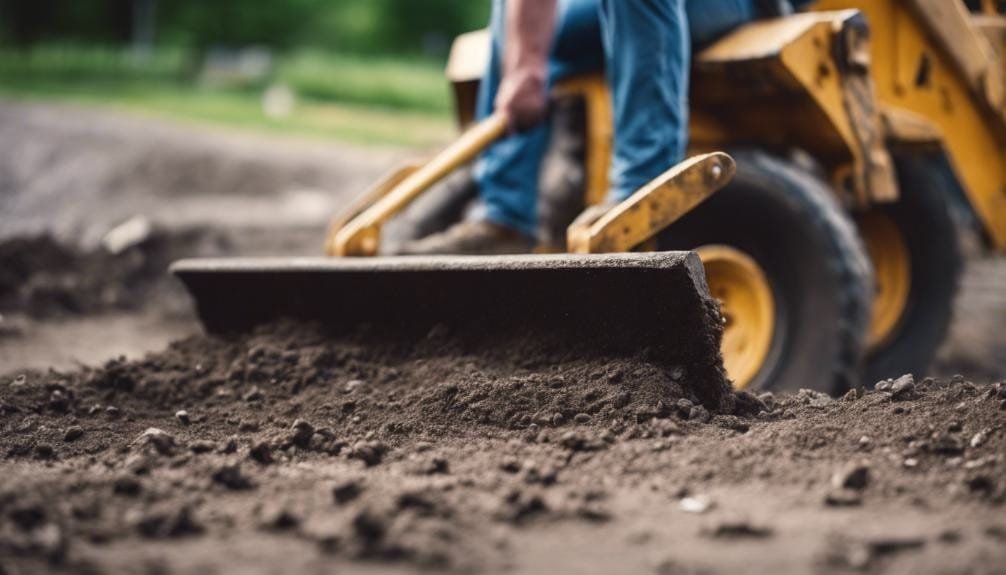
Before starting the installation process of your asphalt driveway, how should you guarantee the site is properly prepared?
To make sure a successful paving project, the first step is to clear the area of any debris, vegetation, or obstacles. This creates a clean slate for the installation process.
Next, it’s important to assess the surface for proper drainage. Water accumulation on the driveway can lead to damage over time. Grading the site will help in directing water away from the driveway surface.
Testing the soil stability and compaction is also vital. This step determines if adjustments are needed to create a solid base for the asphalt.
Marking out the boundaries and design layout of the driveway is critical for accurate placement and alignment during installation. Additionally, considering any utility lines or underground structures beforehand will prevent any accidental damage during the project.
Ensure Proper Drainage

To ensure proper drainage for your asphalt driveway, assess the surface for efficient water flow and prevention of water pooling. Essential drainage is vital for the longevity and performance of your driveway.
During driveway installation, grading plays a key role in ensuring that water runs off the surface effectively. Adequate grading helps in water drainage and prevents water pooling, which can lead to damage over time.
Careful drainage planning is necessary to control runoff and avoid issues such as erosion or standing water. By incorporating proper runoff control measures, you can prevent water pooling on your driveway surface.
Compacting Soil and Subgrade
Assess the compacted soil and subgrade to establish a stable foundation for your asphalt driveway. Proper compaction is vital to prevent settling and ensure a durable surface. Subgrade compaction directly impacts the driveway’s load-bearing capacity and overall strength. Before adding base material, it is essential to achieve the desired density through effective compaction. Utilizing the right compaction equipment will help you attain the necessary density levels for peak driveway performance.
| Compacting Soil and Subgrade | |
|---|---|
| Benefits | Ensure stability, prevent settling |
| Importance | Enhance load-bearing capacity, improve durability |
| Equipment | Select appropriate compaction equipment |
| Considerations | Achieve desired density for peak strength |
| Maintenance | Monitor settling over time for any adjustments |
Add Subbase Material
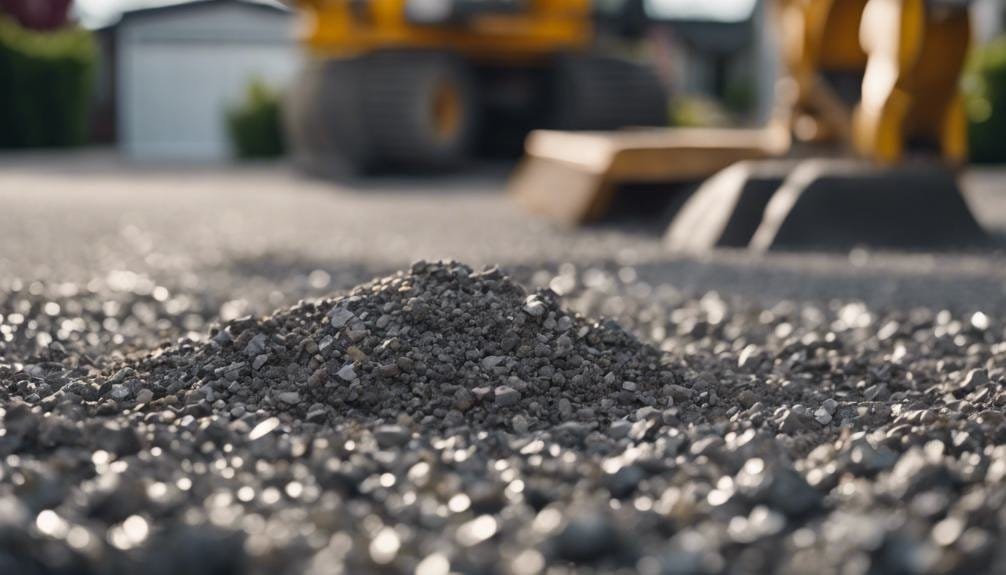
For important stability and longevity of your asphalt driveway, start by adding the required subbase material. The subbase material serves as a vital foundation, supporting the upper layers of the driveway. Options for subbase material include crushed rocks, recycled asphalt, or concrete. Each material has its advantages, so choose based on your project requirements and expected traffic load.
Proper compaction of the subbase material is essential to guarantee durability and prevent issues like settling or cracking over time. The subbase material also helps to prevent frost heave, which can be damaging in colder climates. By selecting the appropriate subbase material and ensuring thorough compaction, you set the stage for a successful asphalt driveway installation.
Take the time to prepare the foundation correctly, as it will greatly impact the performance and lifespan of your driveway.
Apply Binder Course
Prepare the surface by ensuring it’s clean and free of debris before applying the binder course.
The binder course, an important layer in the asphalt paving process, consists of asphalt mixed with larger aggregate and oil. This layer plays a significant role in providing strength and durability to the new surface.
By creating a smooth surface, the binder course ensures the driveway can withstand heavy traffic over time. It acts as a strong foundation for the final layer of fresh asphalt, enhancing the overall structural integrity of the pavement.
Proper application of the binder course is essential for improving the longevity of the driveway. Its primary purpose is to fortify the pavement, making it capable of enduring the stresses of regular use.
This step is critical in establishing a resilient and long-lasting asphalt driveway that can withstand varying weather conditions and maintain its quality under heavy traffic conditions.
Lay Finish Course of Asphalt
To proceed after applying the binder course, the next step involves laying down the finish course of asphalt on the prepared surface. The finish course is an essential component of creating a durable and visually appealing asphalt driveway.
This final layer typically consists of small aggregate, sand, and oil mixed together to form a smooth and cohesive surface. Installing the finish course correctly is vital for ensuring a long-lasting and aesthetically pleasing driveway.
By carefully preparing the surface and meticulously laying the finish course, you can achieve a level and visually attractive asphalt driveway. The finish course serves as the surface course that provides the driveway with its durability and overall appeal.
Paying attention to the details during this step will result in a durable surface that enhances the overall look of your asphalt driveway.
Compact Each Layer
Achieving proper compaction of each layer during the asphalt driveway installation process is imperative for guaranteeing its long-term durability and structural integrity.
To guarantee the longevity of your new asphalt driveway, it’s essential to engage in the compaction process diligently. Proper compaction reduces the risk of issues such as cracking or sinking over time.
Utilizing a heavy roller is vital for compacting each layer uniformly, which in turn contributes to a smooth surface finish. By compacting each layer adequately, you aren’t only enhancing the durability of the driveway but also maintaining its structural integrity.
The heavy roller plays a critical role in tightly packing the asphalt layers, ensuring a secure and robust surface.
Seal the Driveway Regularly
For essential protection and longevity of your asphalt driveway, regular sealing every 2-3 years is important to safeguard against UV rays, water damage, and oil spills. Driveway sealcoating plays a significant role in extending the lifespan of your asphalt surface by acting as a barrier against harmful elements. By investing in this maintenance step, you can effectively prevent cracks, potholes, and fading, ultimately saving you from costly repairs down the line.
Moreover, sealants help maintain the smooth and attractive appearance of your driveway, preserving its durability and aesthetics. By sealing your driveway regularly, you ensure that it remains flexible and strong, reducing the risk of cracks caused by temperature fluctuations. This proactive approach not only prevents damage but also enhances the overall longevity of your asphalt surface.
Maintenance Tips
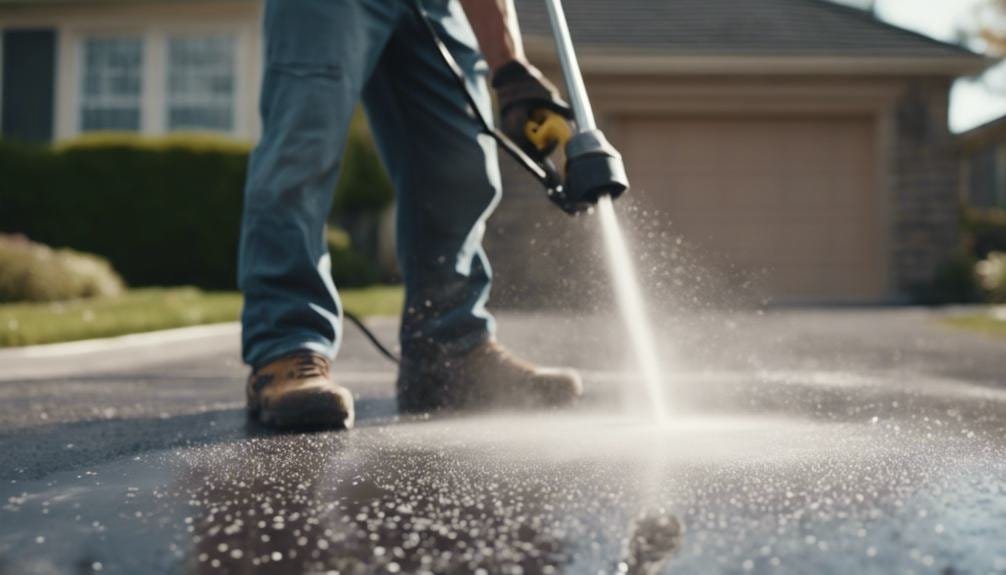
Regularly maintaining your asphalt driveway is crucial for preserving its longevity and appearance. To guarantee your driveway stays in top condition, consider the following maintenance tips:
| Maintenance Tips | Description |
|---|---|
| Regular Seal-Coating | Apply a high-quality sealer every 3-5 years to protect the surface from UV rays and water damage. |
| Patching Cracks | Promptly patch up any cracks or holes to prevent water seepage and further deterioration. |
| Professional Maintenance Checks | Schedule annual checks with a professional to detect early damage signs and prevent worsening. |
| High-Quality Sealer | Use a premium driveway sealer to extend the asphalt’s lifespan by preventing oxidation and moisture penetration. |
Incorporate these practices into your routine to uphold the quality of your driveway. Remember that timely repairs and regular cleaning are key to maintaining the appearance and functionality of your asphalt surface.
Conclusion
Now that you have followed these easy steps for installing your asphalt driveway, you can enjoy a smooth and durable surface for years to come. Remember to seal the driveway regularly to maintain its integrity.
With proper maintenance, your driveway will continue to provide a safe and attractive entrance to your home.
So go ahead, park your car and admire your newly installed asphalt driveway – a job well done!
